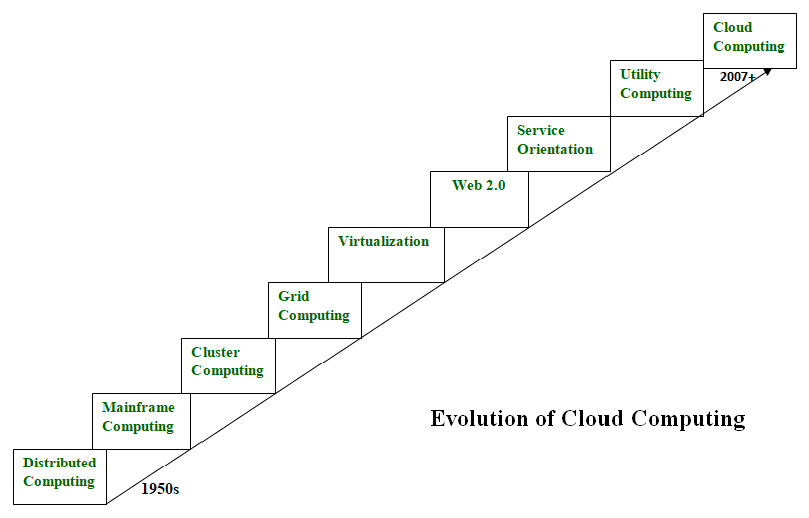728x90
Ch01. Intro to cloud computing
Summary
- 클라우드 컴퓨팅은 인터넷 상으로 컴퓨팅 리소스를 필요한 만큼만 사용할 수 있도록 해는 기술이다. 유저의 필요에 따라 확장이 유연하다
- 클라우드 컴퓨팅은 1950년 메인 프레임(main frame)으로 시작했으며, 가상화 기술과 Hypervisor가 기술의 핵심이다
- 회사에서 클라우드 컴퓨팅을 도입하기 위해 비즈니스의 조건, 투자, 리스크 감당 역량 등을 고려해야 한다
- 클라우드화는 빠르게 진행되고 있으며, 이와 관련된 기업은 주로 AWS, Alibaba, Google, IBM, Microsoft 등이 있다.
Denifition and essential characteristics of cloud computing
What is cloud computing?
- It is delivery of on-demand computing resources
- a model for enabling convenient, on-demand network access to a shared pool of configurable computing resources that can be rapidly provisioned and released with minimal management effort or service provider interaction. (def by NIST:US National Institute of Standards and Technology)
- For example of computing resources, networks, servers, storage, applications, services, etc.
5 Key characteristics of cloud computing
On-demand self-service: enable to get cloud resources easily without human's manual efforts like processing power, storage.Broad network access: access to computing resources via standard mechanisms and platforms like phones, computer.Resource pooling: economies of scales makes cost-efficientRapid elasticity: scale fast when you needMeasured service: pay as much you used
3 types of cloud deployment models
- Public : get cloud service over open internet by cloud provicer. But resoureces are shared by other companies.
- Private : exclusive use by single user.
- Hybrid : mix of both
3 Service models
- Application(SaaS) : get software licensing and delivery model. It also called "on-demand software".
- Platform(Paas) : get access to hardware and software tool that is used for developing and deploying applications to users over the Internet.
- Infrastructure(IaaS) : get access to infrastructure and physical computing resources like servers, networks, storage, and data center. User don't need to care of managing those.
History and Evolution of Cloud Computing
- 1950s : Starting of cloud computing. Large-scale mainframes with high-volume processing power. Many users can share same storage, layer and CPU power
- 1970s : Virtual Machine(VM). multiple distinct compute environments in one single physical hardware.
Virtualization
In the past, VM OS was important because resoureces were expensive. But today It gets cheaper and now virtualization technology is applied to many things like shared hosting environment, virtual private server, virtual dedicated servers.
VM use Hypervisor, software layer that can makes multiple OS sharing one physical machine.
Business Impact
Pay-as-you-go business model of cloud computing switched from CapEx(Capital Expense of High up-front costs) to OpEx(Operating Expense, lo up-front costs).


Considerations for cloud computing
Things to consider before adopting cloud
- Infractructor and workloads : how much does it cost to build data centers?
- Saas and development platforms : leasing or buying?
- Speed and productivity
- Risk capacity
Benefits of cloud adoption
- Flexibility : easy scale up and back. Customization. Open access.
- Efficiency : fast start. Less worries about hardware failure
Challenges of cloud adoption
- data security, loss of data
- gevernance issues
- legal, regulation issues
- lack of standardization
- choosing right deployment and service models
Cloud Service Providers and Servies
Cloud service provides
- Alibaba Cloud(Aliyun)
- Largest Chinese cloud providers
- analytics, network, storage, iot, communication, application development ,compute
- AWS
- devops, iot, machine learning, networking, robotics, data analytics, content delivery, compute
- Google Cloud(GCP)
- infrastructure, platform, serverless computing
- Salesforce
- sales cloud - service cloud - marketing cloud
- Oracle
- wide ragning applications: ERP, Cloud DB services, sales, marketing, HCM, SCM
- Microsoft Azure
- application & services : building, testing, deploying, managing
- IBM Cloud
- products&services : data analytics, compute, network, storage, management
- prominent offering : bare metal servers, VMWare hosting, virtual private cloud, blockchain, AI(Watson)
- SAP
- enterprise software and applications : ERP, CRM, HR, finance
Ch02. Business Case for Cloud Computing
By adopting of cloud technologies, enterprises can be more agile and competitive.
Trends
- 74% have adopted cloud to improve customer experience
- 71% use cloud to build better product while downsizing legacy systems
- Product lifecycles is being shortened, and huddle became lower
Ch03. Emerging techs accelerated by cloud
- IOT(Internet of Things)
- datas such as thermal, optical, structural, environmental datas
- ex) device registration, device identity, storing data, accessing enterprise data
- AI(Artificial Intelligence)
- ex) smart assistants : learn user's preference from user history
- Blockchain
- secure distributed open tech to speed up transactional application. Immutable networks.
- Analytics
- analytics tech leverage the cloud by tracking trends of social media to predict future events
- analyze data to build machine learning models in cognitive applications
- data analytics and predictive maintenance solutions for city infrastructure

728x90
'Research > AWS' 카테고리의 다른 글
| AWS Cloud Practitioner(CLF-C02) ExamTopic 문제 풀이(#4-20) (1) | 2023.11.16 |
|---|---|
| AWS_주요 제품들 (0) | 2023.04.26 |
| AWS Lambda_REST API Trigger로 함수 호출하기 (0) | 2023.04.12 |
| AWS Lambda_HTTP API Trigger로 함수 호출하기 (0) | 2023.04.12 |
| AWS lambda_컨테이너로 함수 생성하기 (0) | 2023.04.12 |



댓글